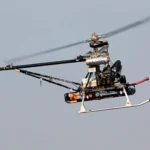Nowadays, a wide range of unmanned aerial vehicles equip an electric motor. They are very extended due to several reasons: efficiency, minimal size, low weight and rotor inertia, high reliability and long life. On top of that, they need almost no maintenance during its lifecycle.
Probably, the most used kind of electric motor is the so-called permanent magnet synchronous motor (PMSM). A PMSM uses permanent magnets embedded in the steel rotor to create a constant magnetic field. The stator carries windings connected to an AC supply to produce a rotating magnetic field. Hence, the key factor is to control this magnetic field in such a way that one could get the best of our energetic resources as well as the most of the motor we have fit in terms of efficiency and power.
Telling your motor how to behave
So focusing on controlling the magnetic field, the most extended technique is what is called Vector Control. This approach can be divided likewise into three different technologies:
FOC (Field Oriented Control): The most widely known. This one takes the measurements of the stator currents and transforms them to a two-phase system (Clarke) to be used after to get a static reference frame currents (Park). Simplistically, these currents are used to command a certain torque and extended, a certain speed.
VVC (Voltage Vector Control): This scheme does not require feedback from the position of the rotor and like FOC some transformations are performed during its functioning. The disadvantages include high torque overhoots as well as a higher ripple than in case of using FOC.
DTC (Direct Torque Control): An alternate to FOC, all calculations are performed in the stator reference frame. It provides a really quick response to load changes, however, its steady state shows high ripples levels of the stator current, flux linkage and torque, especially at low speed.

Embention Motor Control Systems – Efficiency and Power
Embention offers its customers the possibility of getting cutting-edge products including the latest implementations of FOC control, DO178B and DO254 compliant. Among these product Embention is proud to introduce the following:
GIM3: a small brushless control device, particularly an ESC for critical actuator control that can be controlled through PWM, CAN, or I2C interfaces. It is well used for brushless motor control including advanced features for precision applications. Veronte GIM3 can track angular position by a built-in control mechanism using encoder signal input for precise motor positioning.
MC280: an evolution of GIM3 with superior performance that copes with nominal currents up 300 A offering real time telemetry and fully configurable. Suitable for small to medium size UAVs.
MC25KW: the next step, an evolution of MC280 designed to meet the highest standards that provides a total power of 2500kW. Accurate sensored and sensorless control, meant for eVTOL applications.

Making the Right Choice
As a key subsystem of your UAS, choosing a motor controller can make the difference in terms of reliability, efficiency and performance. In Embention, we believe that quality is the most important factor to deliver to our customers and that is why we offer a full range of ESC that meet the DO standards and implement the efficient FOC approach.
In addition, we have designed three different options according to the application so all the needs in the market can be covered, because it is great to have the power under our control.




